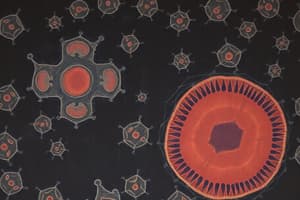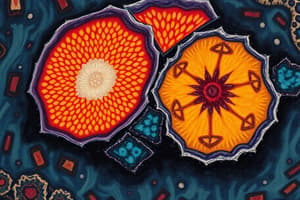Podcast
Questions and Answers
What defines a prokaryotic cell?
What defines a prokaryotic cell?
- It is small and simple without a nucleus. (correct)
- It contains complex organelles.
- It is always a multi-celled organism.
- It has a defined nucleus.
Which organelle is responsible for modifying proteins in a human white blood cell?
Which organelle is responsible for modifying proteins in a human white blood cell?
- Smooth ER
- Nucleus
- Golgi Body
- Rough ER (correct)
Which structure acts as the gateway between the nucleus and cytoplasm?
Which structure acts as the gateway between the nucleus and cytoplasm?
- Nuclear envelope (correct)
- Nucleoplasm
- Cell membrane
- Nucleolus
What is the primary component of a biofilm?
What is the primary component of a biofilm?
What distinguishes eukaryotic cells from prokaryotic cells?
What distinguishes eukaryotic cells from prokaryotic cells?
Which of the following is NOT an organelle found in eukaryotic cells?
Which of the following is NOT an organelle found in eukaryotic cells?
Which microscope type uses a beam of electrons to visualize specimens?
Which microscope type uses a beam of electrons to visualize specimens?
What is the function of the nucleolus within the nucleus?
What is the function of the nucleolus within the nucleus?
Flashcards are hidden until you start studying
Study Notes
Cell Definition
- The smallest unit that exhibits the characteristics of life.
- Organelles are structures within cells that perform specialized metabolic functions, such as building, modifying, and storing substances.
Simple Animal Cell
- Contains cytoplasm, DNA, a nucleus, a nucleoid, and a cell membrane.
Types of Cells
- Eukaryotic Cells:
- Cells with a nucleus and internal compartments.
- Prokaryotic Cells:
- Small, simple cells lacking a nucleus.
Modern Microscopes
- Light microscopes:
- Use visible light to illuminate and magnify samples.
- Types include:
- Phase-contrast microscopes: Enhance contrast in transparent specimens.
- Reflected light microscopes: Used to examine opaque surfaces.
- Fluorescence microscopes: Illuminate specific molecules with fluorescent dyes.
- Electron microscopes:
- Utilize a beam of electrons for higher magnification and resolution.
- Types include:
- Transmission electron microscope (TEM): Provides thin slices of samples for detailed internal structures.
- Scanning electron microscope (SEM): Provides three-dimensional external views of samples.
Prokaryotes
- Prokaryotes are single-celled organisms.
- They include bacteria and archaea.
- They are the smallest and most metabolically diverse forms of life.
Biofilm
- A community of single-celled organisms embedded in a self-produced matrix of polysaccharides and glycoproteins.
- Includes bacteria, algae, fungi, protists, and archaeans.
Eukaryotic Cells
- They include protists, fungi, plants, and animals.
- Contain a nucleus that houses their DNA.
- Have various organelles, including:
- Cell wall: Provides structural support, found in plants, fungi, and some protists.
- Vacuole: Storage compartment, large in plant cells.
- Plasma membrane: Regulates the passage of molecules in and out of the cell.
- Mitochondrion: Powerhouse of the cell, generates ATP through cellular respiration.
- Nucleus: Contains the cell's genetic material (DNA) and is responsible for controlling cell functions.
- Central vacuole: Large storage compartment in plant cells, filled with water and dissolved substances.
- Chloroplast: Site of photosynthesis in plants, contains chlorophyll.
- Cytoskeleton: Network of protein fibers that provides structural support, facilitates movement, and transports materials.
- Microtubules: Largest cytoskeletal fibers, involved in cell division, organelle movement, and structure.
- Microfilaments: Thinner cytoskeletal fibers, involved in muscle contraction, cell division, and maintaining cell shape.
- Intermediate filaments: Intermediate-sized cytoskeletal fibers, provide structural support for the cell.
- Plasmodesma: Channel connecting the cytoplasm of neighboring plant cells.
- Plasma Membrane: Controls movement of molecules into and out of the cell.
- Ribosomes: Sites of protein synthesis, found free in the cytoplasm or attached to the endoplasmic reticulum.
- Rough ER: Network of membranes studded with ribosomes, modifies proteins synthesized by ribosomes.
- Smooth ER: Network of membranes without ribosomes, synthesizes lipids, breaks down carbohydrates and fats, and detoxifies harmful substances.
- Golgi Body: Processes and packages lipids, enzymes, and proteins for distribution within the cell or export.
- Lysosome-Like Vesicle: Contains digestive enzymes to break down cellular waste and foreign substances.
Human White Blood Cell
- Contains numerous organelles, including:
- Rough ER: Modifies proteins made by ribosomes attached to it.
- Smooth ER: Synthesizes lipids, breaks down carbohydrates and fats, and inactivates toxins.
- Golgi Body: Finishes, sorts, and ships lipids, enzymes, and proteins.
- Lysosome: Digests and recycles materials within the cell.
- Nuclear pore: Regulates the movement of molecules between the nucleus and the cytoplasm.
Structure of the Nucleon Envelope
- The nuclear envelope is a double lipid bilayer.
- Proteins embedded in the envelope control molecule transport between the nucleus and cytoplasm.
Structure of the Nucleus
- Nucleoplasm: The viscous fluid within the nuclear envelope, similar to cytoplasm.
- Nucleolus: A dense region within the nucleus where ribosome subunits are assembled from proteins and RNA.
Studying That Suits You
Use AI to generate personalized quizzes and flashcards to suit your learning preferences.



